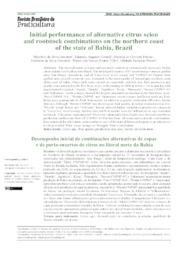Initial performance of alternative citrus scion and rootstock combinations on the northern coast of the state of Bahia, Brazil.
Initial performance of alternative citrus scion and rootstock combinations on the northern coast of the state of Bahia, Brazil.
Autoria: AMORIM, M. da S.; GIRARDI, E. A.; FRANÇA, N. de O.; GESTEIRA, A. da S.; SOARES FILHO, W. dos S.; PASSOS, O. S.
Resumo: The diversification of scion and rootstock varieties is tremendously necessary for the citrus industry in Northeastern Brazil. The initial performance of 13 sweet orange varieties grafted onto ?San Diego? citrandarin, and of ?Cara-Cara? navel orange and ?CNPMF-02 Persian? lime grafted onto several rootstocks was evaluated in the municipality of Inhambupe, northern coast of the state of Bahia. Three trials were carried out separately, and tree size, fruit production and quality were assessed in the first three crops, with planting in 2008 at 6.0 m x 3.0 m spacing with supplemental irrigation. ?Aquiri?, ?Biondo?, ?Agridoce?, ?Kona?, ?Pineapple?, ?Russas CNPMF-03? and ?Salustiana? sweet oranges showed the largest cumulative production in the first three crops. ?Pera CNPMF D-6?, ?Westin CNPMF? and ?Salustiana? sweet oranges had fewer seeds per fruit, being more appropriate for fresh fruit market, in addition to greater production efficiency for the first one. Although ?Westin CNPMF? has shown good fruit quality, its initial production was low. ?Florida? rough lemon and ?Volkamer? lemon induced higher cumulative production compared to ?Cara Cara? navel orange, but tree size and fruit quality were not influenced by any evaluated rootstock. ?Cleopatra? mandarin and ?Riverside? citrandarin led to higher tree size and cumulative production and heavier fruits of ?CNPMF-02 Persian? lime. All scion and rootstock combinations have potential for cultivation on the northern coast of the state of Bahia and appear as an alternative to the prevalent ?Pera? sweet orange on ?Rangpur? lime combination.
Ano de publicação: 2018
Tipo de publicação: Artigo de periódico
Unidade: Embrapa Mandioca e Fruticultura
Palavras-chave: Citrus, Diversificação de Cultura, Fruit quality, Fruta Cítrica
Observações
1 - Por padrão são exibidas publicações dos últimos 20 anos. Para encontrar publicações mais antigas, configure o filtro ano de publicação, colocando o ano a partir do qual você deseja encontrar publicações. O filtro está na coluna da esquerda na busca acima.
2 - Para ler algumas publicações da Embrapa (apenas as que estão em formato ePub), é necessário ter, no celular ou computador, um desses softwares gratuitos. Sistemas Android: Google Play Livros; IOS: iBooks; Windows e Linux: software Calibre.
Acesse outras publicações
Acesse a Base de Dados da Pesquisa Agropecuária (BDPA) para consultar o acervo completo das bibliotecas da Embrapa.

